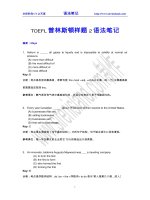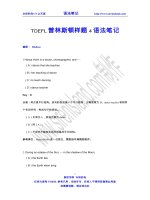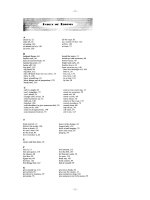Tài liệu Reading_comprehension doc
Bạn đang xem bản rút gọn của tài liệu. Xem và tải ngay bản đầy đủ của tài liệu tại đây (85.75 KB, 11 trang )
Reading comprehension
Editor : HoangCL
Read the following passage and answer the
questions:
Lesson 6
Surrealism was a movement in graphic art and literature that was founded in Paris, in
1924, by Andr Breton. Inspired by another movement in art called Dadaism, the
Surrealist movement has been one of the most influential art movements in the 20th
century. It eventually 5 had a worldwide audience, flourishing notably in the United
States during World War II. Surrealism focused on the role of the unconscious in the
creative process. In a nihilistic protest, it rejected all aspects of Western culture.
Surrealist writers, such as Aragon and Soupalt, believed in directly transcribing onto
paper anything their 10 unconscious mind wished them to. They never altered or revised
what they wrote because that would have interfered with the purity of their creation.
Surrealist painters, a group that included such famous names as Miro, Dali, and Ernst,
displayed a wide variety of style and content. Though Breton was the founder of this
movement, his 15 strong leadership style brought about dissent, which resulted in several
of the painters officially breaking away from the movement.
1. With what topic is this passage primarily concerned?
(A) influential painters such as Miro, Dali, and Ernst
(B) the Surrealist movement in graphic art and literature
(C) nihilism as an aspect of the Surrealist movement
(D) Andr Breton’s leadership style
2. As used in line 1, which of the following is the closest in meaning to the phrase”a
movement”?
(A) a trend
(B) an action
(C) an exercise
(D) a gesture
3. Which of the following is closest in meaning to the word “inspired” in line 2?
(A) excited
(B) influenced
(C) stifled
(D) created
4. Why does the author mention Dadaism?
(A) to demonstrate the importance of Surrealism
(B) to give background information about Surrealism
(C) to show the lack of influence of Dadaism
(D) to infer that Andr Breton rejected Dadaism
5. What does “it” refer to in line 7?
(A) a protest
(B) the unconscious
(C) Surrealism
(D) the creative process
6. The word “altered” in line 10 means
(A) changed
(B) forgot
(C) believed
(D) allowed
7. Which of the following is closest to the meaning of “purity” in line 11?
(A) integrity
(B) fragility
(C) dignity
(D) simplicity
8. According to the passage, all of the following are true of Surrealism EXCEPT?
(A) Surrealism was influenced by Dadaism.
(B) Surrealists believed that the unconscious played an important role in the creative
process.
(C) Some Surrealist painters quit the official movement because of Andr Breton.
(D) Surrealism embraced Western culture.
9. The word “displayed” in line 13 is closest in meaning to which of the following?
(A) neglected
(B) replaced
(C) exhibited
(D) condemned
10. The word “dissent” in line 15 is closest inmeaning to which of the following?
(A) disagreement
(B) distress
(C) distraction
(D) discouragement
11. The phrase “breaking away” in line 16 means
(A) escaping
(B) separating
(C) defecting
(D) passing
12. Which of the following statements is best supported by this passage?
(A) Andr Breton founded art and literature in Paris.
(B) Andr Breton rejected Dadaism because of Nihilism.
(C) Andr Breton supported Miro in his painting.
(D) Andr Breton was a vital part of the Surrealist movement.
Lesson 7
May 7, 1840, was the birthday of one of the most famous Russian composers of the
nineteenth century Peter Illich Tchaikovsky. The son of a mining inspector, Tchaikovsky
studied music as a child and later studied composition at the St. Petersburg Conservatory.
His greatest 5 period of productivity occurred between 1876 and 1890, during which time
he enjoyed the patronage of Madame von Meck, a woman he never met, who gave him a
living stipend of about $1,000.00 a year. Madame von Meck later terminated her
friendship with Tchaikovsky, as well as his living allowance, when she, herself, was
facing financial 10 difficulties. It was during the time of Madame von Meck’s patronage,
however, that Tchaikovsky created the music for which he is most famous, including the
music for the ballets of Swan Lake and The Sleeping Beauty. Tchaikovsky’s music, well
known for its rich melodic and sometimes melancholy passages, was one of the first that
brought 15 serious dramatic music to dance. Before this, little attention had been given to
the music behind the dance. Tchaikovsky died on November 6, 1893, ostensibly of
cholera, though there are now some scholars who argue that he committed suicide.
1. With what topic is the passage primarily concerned?
(A) the life and music of Tchaikovsky
(B) development of Tchaikovsky’s music for ballets
(C) Tchaikovsky’s relationship with Madame Von Meck
(D) the cause of Tchaikovsky’s death
2. Tchaikovsky’s father was most probably
(A) a musician
(B) a supervisor
(C) a composer
(D) a soldier
3. Which of the following is closest in meaning to the word “productivity” in line 5?
(A) fertility
(B) affinity
(C) creativity
(D) maturity
4. In line 6, the phrase “enjoyed the patronage of” probably means
(A) liked the company of
(B) was mentally attached to
(C) solicited the advice of
(D) was financially dependent upon
5. Which of the following could best replace the word “terminated” in line 8?
(A) discontinued
(B) resolved
(C) exploited
(D) hated
6. According to the passage, all of the following describe Madame von Meck EXCEPT:
(A) She had economic troubles.
(B) She was generous.
(C) She was never introduced to Tchaikovsky.
(D) She enjoyed Tchaikovsky’s music.
7. Where in the passage does the author mention Tchaikovsky’s influence on dance?
(A) May 7 . . . St. Petersburg Conservatory.
(B) Madam von Meck later terminated . . . finacial difficulties.
(C) It was during . . . The sleeping Beauty.
(D) Tchaikovsky’s music . . . Committed suicide.
8. According to the passage, for what is Tchaikovsky’s music most well known?
(A) its repetitive and monotonous tones
(B) the ballet-like quality of the music
(C) the richness and melodic drama of the music
(D) its lively, capricious melodies
9. According to the passage, “Swan Lake” and “The Sleeping Beauty” are
(A) dances
(B) songs
(C) operas
(D) plays
10. Which of the following is NOT mentioned in the passage?
(A) Tchaikovsky’s influence on ballet music
(B) Tchaikovsky’s unhappiness leading to suicide
(C) the patronage of Madame von Meck
(D) Tchaikovsky’s productivity in composing
11. Which of the following is closest in meaning to the word “behind” as used in line 16?
(A) supporting
(B) in back of
(C) going beyond
(D) concealing
12. In line 17, the word “ostensibly” could be best replaced by
(A) regretfully
(B) assuredly
(C) tragically
(D) apparently
Lesson 8
Since the world has become industrialized, there has been an increase in the number of
animal species that have either become extinct or have neared extinction. Bengal tigers,
for instance, which once roamed the jungles in vast numbers, now number only about
2,300, and by 5 the year 2025 their population is estimated to be down to zero. What is
alarming about the case of the Bengal tiger is that this extinction will have been caused
almost entirely by poachers who, according to some sources, are not interested in
material gain but in personal gratification. This is an example of the callousness that is
part 10 of what is causing the problem of extinction. Animals like the Bengal tiger, as
well as other endangered species, are a valuable part of the world’s ecosystem.
International laws protecting these animals must be enacted to ensure their survival, and
the survival of our planet.
15 Countries around the world have begun to deal with the problem in various ways.
Some countries, in order to circumvent the problem, have allocated large amounts of land
to animal reserves. They then charge admission to help defray the costs of maintaining
the parks, 20 and they often must also depend on world organizations for support. With
the money they get, they can invest in equipment and patrols to protect the animals.
Another solution that is an attempt to stem the tide of animal extinction is an international
boycott of products made from endangered species. This seems fairly effective, but it 25
will not, by itself, prevent animals from being hunted and killed.
1. What is the main topic of the passage?
(A) the Bengal tiger
(B) international boycotts
(C) endangered species
(D) problems with industrialization
2. Which of the following is closest in meaning to the word “alarming” in line 6?
(A) dangerous
(B) serious
(C) gripping
(D) distressing
3. Which of the following could best replace the word “case” as used in line 6?
(A) act
(B) situation
(C) contrast
(D) trade
4. The word “poachers” as used in line 7 could be best replaced by which of the
following?
(A) illegal hunters
(B) enterprising researchers
(C) concerned scientists
(D) trained hunters
5. The word “callousness” in line 9 could best be replaced by which of the following?
(A) indirectness
(B) independence
(C) incompetence
(D) insensitivity
6. The above passage is divided into two paragraphs in order to contrast
(A) a problem and a solution
(B) a statement and an illustration
(C) a comparison and a contrast
(D) specific and general information
7. What does the word “this” refer to in line 9?
(A) endangered species that are increasing
(B) Bengal tigers that are decreasing
(C) poachers who seek personal gratification
(D) sources that may not be accurate
8. Where in the passage does the author discuss a cause of extinction?
(A) Since the world . . . down to zero.
(B) What is alarming . . . personal gratification.
(C) Country around . . . for support.
(D) With the money . . . dangered species.
9. Which of the following could best replace the word “allocated” in line 17?
(A) set aside
(B) combined
(C) organized
(D) taken off
10. The word “defray” in line 19 is closest in meaning to which of the following?
(A) lower
(B) raise
(C) make a payment on
(D) make an investment toward
11. The author uses the phrase “stem the tide” in line 22-23 to mean
(A) touch
(B) stop
(C) tax
(D) save
12. Which of the following best describes the author’s attitude?
(A) forgiving
(B) concerned
(C) vindictive
(D) surprised
Lesson 9
A balanced diet contains proteins, which are composed of complex amino acids. There
are 20 types of amino acids, comprising about 16 percent of the body weight in a lean
individual. A body needs all 20 to be healthy. Amino acids can be divided into two
groups: essential 5 and nonessential. There are 9 essential amino acids. These are the
proteins that the body cannot produce by itself, so a healthy individual must ingest them.
The 11 nonessential amino acids, on the other hand, are produced by the body, so it is not
necessary to ingest them. Proteins are described as being either high-quality or low-
quality, 10 depending on how many of the 9 essential amino acids the food contains.
High-quality proteins, typically found in animal meats, are proteins that have ample
amounts of the essential amino acids. Low-quality proteins are mainly plant proteins and
usually lack one or more of the essential amino acids. Since people who follow a strict
vegetarian 15 diet are ingesting only low-quality proteins, they must make sure that their
diets contain a variety of proteins, in order to ensure that what is lacking in one food is
available in another. This process of selecting a variety of the essential proteins is called
protein complementation. Since an insufficient amount of protein in the 20 diet can be
crippling, and prolonged absence of proteins can cause death, it is imperative that a
vegetarian diet contains an ample amount of the essential proteins.
1. With what topic is this passage primarily concerned?
(A) the 20 types of amino acids
(B) high- and low-quality proteins
(C) the process of complementation
(D) healthy diets for vegetarians
2. The word “lean” in line 3 could be best replaced by
(A) thin
(B) fat
(C) tall
(D) short
3. The word “ingest” in line 7 is closest in meaning to which of the following?
(A) chew
(B) swallow
(C) suck
(D) drink
4. The word “ample” in line 13 is closest in meaning to which of the following?
(A) meager
(B) frequent
(C) substantial
(D) harmful
5. Which of the following would NOT be an example of a low-quality protein?
(A) legumes
(B) apples
(C) grains
(D) tuna
6. As used in line 14, which of the following words is closest in meaning to “strict”?
(A) responsible
(B) casual
(C) harmonious
(D) rigid
7. According to the passage, a vegetarian could die from insufficient protein ingestion if
he or she
(A) did not follow a varied and properly protein-complemented diet.
(B) ate too many animal proteins,and could not digest them properly.
(C) did not follow a diet in which nonessential proteins were ingested.
(D) ate too many low-quality proteins.
8. Which of the following is closest in meaning to the word “crippling” as used in line
20?
(A) discouraging
(B) betraying
(C) incapacitating
(D) amazing
9. Which of the following words could best replace the word “prolonged” in line 20?
(A) narrow
(B) hollow
(C) hard-hearted
(D) extended
10. In line 21, the word “imperative” can be best replaced by
(A) crucial
(B) impossible
(C) wonderful
(D) satisfying
11. Which of the following best describes the author’s tone in this passage?
(A) forceful
(B) light
(C) casual
(D) argumentative
12. Which statement best describes the organization of this passage?
(A) Contrasting views concerning proteins are compared.
(B) The author moves from a general comment to a specific argument.
(C) A statement is given and its cause is then discussed.
(D) Items are discussed in their order of importance.
Lesson 10
The peregrine falcon, a predatory bird indigenous to North America, was once in danger
of extinction. In the 1960s, scientists discovered byproducts of the pesticide DDT in the
birds’ eggs, which caused them to be too soft to survive. The use of the pesticide had
been 5 banned in the United States, but the falcons were eating migratory birds from
other places where DDT was still used. In order to increase the survival rate, scientists
were raising the birds in laboratories and then releasing them into mountainous areas.
This practice achieved only moderate success, however, because many of the birds raised
10 in captivity could not survive in the wild.
There is now, however, a new alternative to releases in the wild. A falcon that has been
given the name Scarlett chose to make her home on a ledge of the 33rd floor of a
Baltimore, Maryland, office 15 building rather than in the wild, and, to the surprise of the
scientists, she has managed to live quite well in the city. Following this example,
programs have been initiated that release birds like Scarlett into cities rather than into
their natural wild habitat. These urban releases are becoming a common way to
strengthen the species. Urban homes 20 have several benefits for the birds that wild spots
do not. First, there is an abundance of pigeons and small birds as food sources. The
peregrine in the city is also protected from its main predator, the great horned owl. Urban
release programs have been very successful in reestablishing the peregrine falcons along
the East Coast. Though 25 they are still an endangered species, their numbers increased
from about 60 nesting pairs in 1975 to about 700 pairs in 1992. In another decade the
species may flourish again, this time without human help.
1. What is the main topic of the passage?
(A) survival of peregrine falcons
(B) releases into the wild
(C) endangered species
(D) harmful effects of pesticides
2. In line 1, the phrase “indigenous to” could be best replaced by
(A) typical of
(B) protected by
(C) adapted to
(D) native to
3. The word “byproducts” in line 3 could best be replaced by which of the following?
(A) derivatives
(B) proceeds
(C) chemicals
(D) elements
4. In line 5, the word “banned” could be best replaced by
(A) authorized
(B) developed
(C) disseminated
(D) prohibited
5. Which of the following words is closest in meaning to the word “rate,” as used in line
7?
(A) speed
(B) percentage
(C) continuation
(D) behavior
6. In line 7, the word “raising” most probably means
(A) breeding
(B) elevating
(C) collecting
(D) measuring
7. Why were the peregrine falcons in danger?
(A) because of pesticides used by American farmers
(B) because they migrated to countries where their eggs could not survive
(C) because they ate birds from other countries where DDT was still used
(D) because they were prized by hunters and hunted to near extinction
8. The word “releases” as used in line 12 most probably means
(A) internment
(B) regression
(C) distribution
(D) possessions
9. The word “ledge” in line 14 is closest in meaning to
(A) window
(B) wall
(C) terrace
(D) shelf
10. According to the passage, which of the following is NOT a reason why a falcon might
choose to live in a city?
(A) There are high places to nest.
(B) There are other falcons nearby.
(C) There is a lack of predators.
(D) There is abundant food.
11. According to the passage, which of the following are the falcon’s main predators?
(A) pigeons
(B) rattlesnakes
(C) owls
(D) humans
12. As used in line 20, the word “spots” could best be replaced by
(A) places
(B) dilemmas
(C) jungles
(D) materials
13. According to the passage, where have the release programs been the most successful?
(A) in office buildings
(B) on the East Coast
(C) in mountainous areas
(D) in the wild









